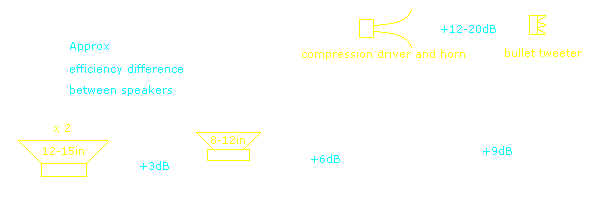3 octaves or (3.32 octaves 1 decade) is the optimum bandwidth for a speaker as previously described. The crossover decreases power at a given rate from either or both sides of a given bandwidth. The slopes rotate phase in opposite directions. In some passive crossovers this is adjusted for by reversing the polarity of adjacent speakers. Electronic active crossovers can have extra compensating circuitry. DSP crossover management can maintain a constant phase at the crossover points.
Crossover points and Order. At the crossover point, in most passive crossovers, power to each speaker is reduced -3dB (1/2) so total sound energy in front of the speaker system is constant. At the crossover point sound comes from 2 sources and on-axis directivity is increased. Recent design trends in active systems, where each speaker, woofer and tweeter, is driven from a separate amplifier, electronic crossovers are used and power is decreased to -6dB (1/4) to each speaker at the crossover point. The slope rate can be selected.

1. First order (-6dB /octave) reduces power to 1/4 per octave, adequate for cheap low power systems.
2. Second order (-12dB /octave) reduces power to 1/16 per octave. Provides the best technical accuracy with the least complications and harmonic distortion. For mid and high speakers the cone or driver diaphragm movement is kept constant as the frequency decreases (constant excursion).
3. Third order (-18dB /octave) reduces power to 1/64 per octave. Is good for protecting speakers at higher power. Also helps reduce bass energy from harming compression drivers with truncated horns.
4. Fourth order (-24dB / octave) reduces power to 1/256 per octave. Is best for maximum control of speakers and requires critical alignment. Fourth order has become the standard crossover for professional systems.
3 laws of Crossovers
- It is not possible to stitch 2 different speakers together, perfectly.
- A crossover should have the minimalist complexity to achieve the desired outcome.
- The more complex a crossover, the more difficult the system is to control.
Selecting crossover points
Our ears are most sensitive to detail between 300Hz to 3kHz. The telephone system operates between these 2 points. Sound system distortion between these points can easily be heard and therefore the worst position to cross speakers over, but we have no choice. The best crossover points for our ears do not line up with the physics of speakers. For domestic use, at low power, crossing tweeters over between 2kHz - 3kHz is often done in 2 way systems. However the tweeter is easily destroyed at higher power particularly when having parties. There has been many attempts to force speakers to be crossed over at 300Hz and 3kHz at higher power but with limited success.

The sound spectrum is large 20Hz to 20kHz (3 Decades or 9 octaves). For home use a passive full range 3-way speaker system is cost effective and adequate for most people. The best way to understand a 4-way speaker system is to approach it a 3-way, with an added active sub-bass. Hopefully the explanations below will make this understandable.
Why 4 - Way ?
(1) Harmonics. For high frequency, most tweeters can be crossed over at 3kHz but can easily be destroyed at high power. The lower a tweeter is crossed over the less power they can handle. Below 6kHz the power rating of most dome, ribbon and bullet tweeters, reduces at -6dB/octave (1/4 power for each octave decrease). Eg. A tweeter rated at 40 Watts will only be capable of 10 Watts at 3kHz. Tweeters should be crossed over at approx 4kHz - 6kHz for maximum dynamic power response. A compression bullet tweeter is approx 12dB - 20dB more efficient than a dome tweeter.
(2) Upper voice. A 4in - 5in speaker may just reach 6kHz linearly but below 400Hz, efficiency reduces at approx -6dB/octave. Compression drivers for professional sound systems are capable of reaching 6kHz but rarely capable of going below 800Hz. A compression driver may be capable of 50 Watts - 100 Watts above 1kHz but below 800Hz a few Watts can easily destroy them. A compression driver and horn is approx 12dB - 24dB more efficient than a cone speaker.

(3) Lower voice. approx 100Hz - 400/800Hz is in-between the bass and upper voice. A heavy cone speaker designed for bass may be able to cover this frequency range but it will not have the efficiency to match the upper voice speaker. An 8in - 12in MB (mid-bass) is similar to a bass speaker but will have a low weight cone with a short voice coil. The MB speaker will be approx 3dB more efficient than a bass speaker but it will still be less efficient than the upper voice speaker (-3dB approx). For professional application, MB lower voice speaker should be at least x 2 power rating of the upper voice speaker, to maintain equal spectral balance.
(4) Bass. At high power, the large physical movement (excursion) of the speaker cone will inter-modulate and distort the lower voice. A separate bass (sub-bass) should be added, to cover the bass notes and be crossed at the lower end of the voice range from approx 90Hz and below. Making the system into a 4 way. Because the bass (sub-bass) speaker is less efficient, 2 bass speakers are required for correct spectral power balance to equal the more efficient MB lower voice speaker. For professional sound systems, 2 bass (sub-bass) speakers for 1 lower voice speaker is essential. For home 1 bass (sub-bass) speaker will be adequate but x 2 or x 4 power will be required, for it to reach the same level as the lower voice speaker.
The best way to understand a 4-way speaker system is to approach it a 3-way with an added active sub-bass. The words bass and sub-bass are ambiguous and often include each other. The lowest bass note on a bass guitar and double bass is open E 42Hz. The musical bass register refers to the lowest 1.5 octaves on the bass instrument 42Hz - 120Hz.
Note Below open E 42Hz (lowest bass note on a double-bass) the efficiency of most bass speakers, decreases at -12dB/octave. At 20Hz a bass speaker may require x 16 more power to bring it to the same level at 40Hz. Our ears are -20dB (1/100) less sensitive to hearing sound at 20Hz compared to 42Hz. Almost no music CDs or vinyl records have music information below 42Hz. Against popular belief very few action movies have sound effects below 42Hz. There are a few audiophile sub-bass speaker systems that go down to 20Hz and are crossed over at approx 60Hz. Professional bass musicians find these audiophile sub-bass systems unusable (un-musical) as a bass speaker system in a band or orchestra.
Efficiency
Efficiency is measured on axis, 1 Watt at 1 meter.
Cone speakers vary between 86 - 96 dB/mW.
Compression drivers and horns, and bullet tweeters, approx 110 dB/mW.

A general rule. An 8in to 12in lower voice speaker (short voice coil - hi resonant - low mass cone) is approx +3dB to +6dB more efficient than a large 12in to 18in bass speaker (long voice coil - low resonant - heavy thick cone). A 4in to 5in upper voice speaker is approx +3dB more efficient than the 8in to 12in lower voice speaker. A dome tweeter is approx +3dB more efficient than the 4in to 5in upper voice speaker. For professional sound systems a compression driver horn and bullet tweeter are approx +12dB to +20dB more efficient than cone speakers.
The efficiency difference between speakers, using passive crossovers, is managed by attenuators called L-pads (similar to a large volume control at the speaker). For active speaker systems the efficiency difference between speakers is managed by adjusting the level controls of the amplifiers.


